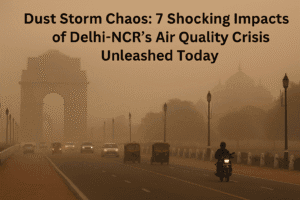Dust Storm Chaos: 7 Shocking Impacts of Delhi-NCR’s Air Quality Crisis Unleashed Today
A severe dust storm engulfed Delhi-NCR on Thursday, drastically reducing visibility and disrupting daily life as strong winds of 30–40 kmph swept through the region. The sudden weather shift, following a prolonged heatwave, left key areas like India Gate and Akshardham shrouded in thick dust, while airport visibility dropped to 1,200 meters. The air quality plummeted to the “poor” category (AQI 236), raising health concerns, particularly for those with respiratory conditions.
Authorities advised residents to stay indoors, wear masks, and avoid outdoor activities as weak winds prevented dust dispersion. This mirrors April’s dust storm, which caused flight delays and a fatal wall collapse, highlighting recurring climate challenges. Experts warn that rising temperatures and erratic winds may increase such events, demanding long-term mitigation strategies. For now, the IMD forecasts continued strong winds, leaving Delhiites bracing for further disruptions. Stay updated via official alerts and prioritize safety during hazardous conditions.

Dust Storm Chaos: 7 Shocking Impacts of Delhi-NCR’s Air Quality Crisis Unleashed Today
A sudden and intense dust storm swept across Delhi-NCR on Thursday, drastically reducing visibility and plunging air quality into the “poor” category. The storm, triggered by abrupt weather changes following a prolonged heatwave, blanketed the region in thick layers of dust, disrupting daily life and raising health concerns.
Chaos and Reduced Visibility
Visuals from across the city showed a hazy grey shroud enveloping prominent landmarks, including Kartavya Path near India Gate and the Akshardham temple. The India Meteorological Department (IMD) reported gusty winds of 30–40 kmph, which kicked up the dust, reducing visibility at Indira Gandhi International Airport from 4,500 meters to just 1,200 meters within 90 minutes on Wednesday night.
By Thursday morning, weak winds (3–7 kmph) prevented the dust from dispersing, leaving visibility hovering between 1,200 and 1,500 meters at Safdarjung and Palam airports. Commuters faced delays as the storm disrupted traffic, while office-goers struggled with poor air conditions.
Air Quality Takes a Hit
The Central Pollution Control Board (CPCB) recorded an Air Quality Index (AQI) of 236—placing Delhi in the “poor” category—after weeks of moderate air quality. The storm’s fine particulate matter (PM2.5 and PM10) poses respiratory risks, especially for vulnerable groups like asthma patients and the elderly.
Safety Advisory Issued
Authorities urged residents to:
- Stay indoors as much as possible.
- Wear masks (N95 or similar) if venturing outside.
- Keep hydrated and avoid strenuous outdoor activities.
- Secure windows and doors to minimize dust ingress.
A Recurring Hazard
This isn’t the first time Delhi-NCR has faced such extreme weather this year. In April 2025, a similar dust storm and unexpected rainfall followed a heatwave, leading to flight disruptions and a fatal wall collapse. Climate experts warn that rising temperatures and erratic wind patterns could make these events more frequent.
What’s Next?
The IMD predicts strong surface winds in the coming days, which may either clear the dust or exacerbate the situation if more particulate matter is stirred up. Residents are advised to monitor updates and take necessary precautions.
Why This Matters
Dust storms aren’t just an inconvenience—they’re a public health crisis. With Delhi’s air pollution already a chronic issue, these sudden weather shifts amplify risks, from road accidents to respiratory emergencies. Long-term solutions, including better urban planning and dust control measures, are critical to mitigating future disasters.
You must be logged in to post a comment.